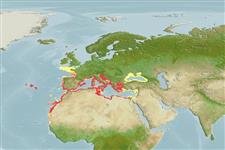Environment: milieu / climate zone / depth range / distribution range
Écologie
marin démersal; profondeur 5 - 150 m (Ref. 27000), usually ? - 30 m (Ref. 91154). Subtropical; 50°N - 16°N, 32°W - 42°E
Eastern Atlantic: Bay of Biscay to Mauritania (Ref. 5377), including the Canary, and Azores. Also from the Mediterranean and the Black Sea.
Length at first maturity / Taille / Poids / Âge
Maturity: Lm 17.3, range 16 - ? cm
Max length : 36.0 cm SL mâle / non sexé; (Ref. 5506); common length : 25.0 cm SL mâle / non sexé; (Ref. 5506); âge max. reporté: 16 années (Ref. 91154)
Found on rocky bottom and on Posidonia beds. Feed on fishes and crustaceans (Ref. 5506). Also found in muddy and algal or seagrass overgrown substrates. Reported to be a simultaneous hermaphrodite, which tends to spawn from early spring to early summer (Ref. 91154).
Tortonese, E., 1986. Serranidae. p. 780-792. In P.J.P. Whitehead, M.-L. Bauchot, J.-C. Hureau, J. Nielsen and E. Tortonese (eds.) Fishes of the north-eastern Atlantic and the Mediterranean. UNESCO, Paris. vol. 2. (Ref. 5506)
Statut dans la liste rouge de l'IUCN (Ref. 130435: Version 2024-2)
Menace pour l'homme
Harmless
Utilisations par l'homme
Pêcheries: intérêt commercial mineur; pêche sportive: oui
Outils
Articles particuliers
Télécharger en XML
Sources Internet
Estimates based on models
Preferred temperature (Ref.
123201): 15.1 - 21, mean 18.4 °C (based on 72 cells).
Phylogenetic diversity index (Ref.
82804): PD
50 = 0.5000 [Uniqueness, from 0.5 = low to 2.0 = high].
Bayesian length-weight: a=0.00977 (0.00830 - 0.01151), b=3.04 (3.00 - 3.08), in cm total length, based on LWR estimates for this species (Ref.
93245).
Niveau trophique (Ref.
69278): 3.8 ±0.3 se; based on diet studies.
Résilience (Ref.
120179): Milieu, temps minimum de doublement de population : 1,4 à 4,4 années (K=0.22-0.24).
Fishing Vulnerability (Ref.
59153): Moderate vulnerability (44 of 100).
Nutrients (Ref.
124155): Calcium = 75.5 [30.7, 150.6] mg/100g; Iron = 0.921 [0.503, 1.748] mg/100g; Protein = 18.3 [16.5, 20.0] %; Omega3 = 0.4 [0.3, 0.7] g/100g; Selenium = 26.7 [14.2, 51.5] μg/100g; VitaminA = 19.7 [6.4, 69.4] μg/100g; Zinc = 0.772 [0.552, 1.131] mg/100g (wet weight);
